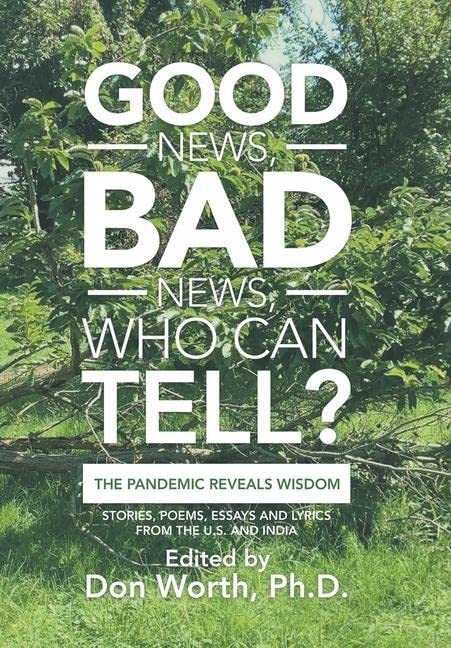Good News, Bad News, Who Can Tell?
The Pandemic Reveals Wisdom: Stories, Poems, Essays and Lyrics from the US and India
The literary collection Good News, Bad News, Who Can Tell? responds to COVID-19 and its crises with clarity, openness, and resilience.
Psychotherapist Don Worth’s collection Good News, Bad News, Who Can Tell? brings a nonjudgmental, multicultural perspective to COVID-19.
Prompted by observations about the psychological impacts of the pandemic (Worth’s patients reported fewer psychological difficulties at its height, he noted, though their problems returned when the lockdowns lifted), this collection asks whether some good came out of the restrictions. It gathers stories, essays, poetry, and song lyrics from the US and India. They cover personal, economic, and social hardships, but also transformative lessons, as when people took the time to get to know themselves, their loved ones, and their communities better.
The book includes contributions from members of nine different groups, including artists, physicians, and teachers. There are COVID-19 survivors represented, as well as people who lost loved ones to the virus. Contributors address the importance of human contact, share creative responses to challenging situations, and extol those who put their lives on the line to serve others.
Herein, Indian poet Manohar Shetty laments a world in which animals are free to roam the streets while humans, locked in their “cages,” look on; his poem envisions a frightening scenario in which everyday people take up weapons against those who threatened them and beat them into compliance. It also describes humans as the “new untouchables.” Another poem, “Contact,” lists those whose livelihood and well-being depends on human touch or proximity to others. It includes a poignant image of a tango dancer dancing alone before a mirror:
All those miracle apps zooming in
Only take you so far.
The embrace beyond words,
Fingertip touching fingertip
Is what you most desire.
Other contributions express wry humor, as when masks are described as the new “haute couture.”
One chapter is filled with pandemic images—of footsteps on floors marking the distance to be maintained between people; of instructions for using elevators and public bathrooms. Elsewhere, there are palpable descriptions of hospital patients dying alone and of their loved ones who were forbidden to be with them. Such memories have a nightmarish quality.
Though it claims to assume a perspective of nonjudgmental observation, the collection does represent a consistent take on events. It is directed by positivity and even suggests visualization exercises in pursuit of a positive future. Its title is proposed as a mantra for maintaining emotional equilibrium, and it deliveries clear pandemic lessons and suggestions for moving forward at its end. Its work, though, is undermined by frequent grammatical errors and misused, missing, and incorrect words.
The literary collection Good News, Bad News, Who Can Tell? gathers prose and poetry pieces that respond to COVID-19 and its crises with clarity, openness, and resilience.
Reviewed by
Kristine Morris
Disclosure: This article is not an endorsement, but a review. The publisher of this book provided free copies of the book and paid a small fee to have their book reviewed by a professional reviewer. Foreword Reviews and Clarion Reviews make no guarantee that the publisher will receive a positive review. Foreword Magazine, Inc. is disclosing this in accordance with the Federal Trade Commission’s 16 CFR, Part 255.

